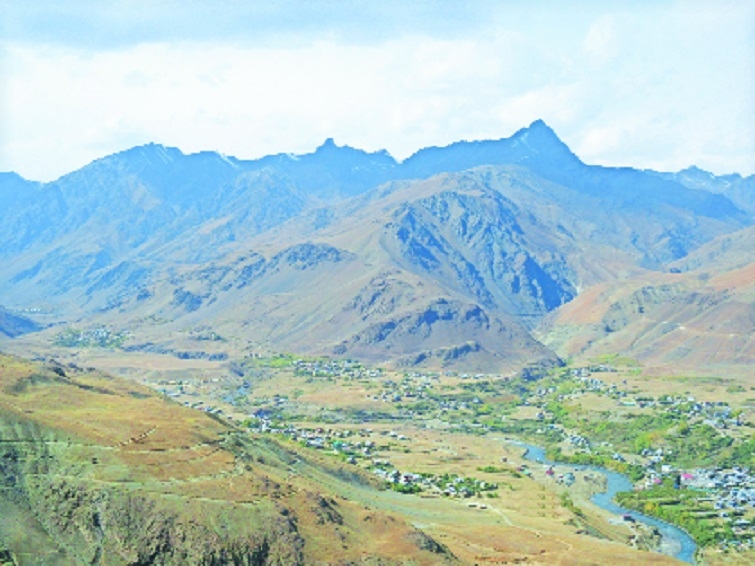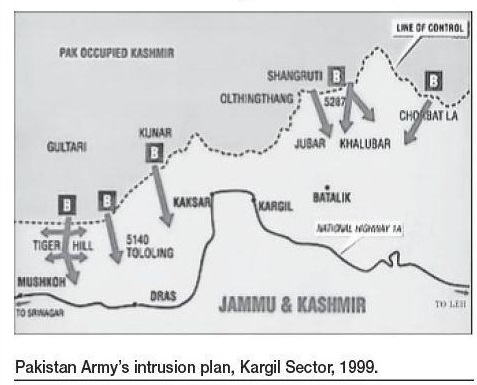1999: FAILURE of Pak’s ‘Op Badr’
| Date :09-Nov-2023 |

The town of Drass with Tiger Hill and other features looming large in the backdrop. (Pic by Kartik Lokhande)
By Kartik Lokhande :
Dateline Kargil-6
Pakistan might have been master of deceit, but it failed to realise even after several defeats that Indian forces’ biggest equipment was determination and bravery.
Garkhun villager Tashi Namgyal’s report served as the first detection of the well-planned intrusion by the Pakistan Army in Kargil Sector in 1999. Similar tips from the locals in other areas, proved to be the tip of the iceberg. Gradually, it became evident that Pakistan had resorted to another military misadventure.
After having failed in 1947-48, 1965, and 1971 in severing the link between Srinagar and Leh via Drass-Kargil axis, an ‘ugly stability’ prevailed in Kargil Sector for a long time. However, it did not mean that Pakistan had abandoned the plan to target Kargil. According to some literature available, an eminent Pakistani writer Altaf Gauhar suggested that Pakistan’s nefarious designs towards Kargil were formulated in 1987 when General Zia ul Haq was at the helm of affairs. Sahibzada Yakub Khan, the then Foreign Minister of Pakistan, however, vetoed the plan as ‘militarily untenable’.
Many believe that the said plan was hatched to avenge
India’s quick response in preventing Pakistan from illegal occupation of Siachen Glacier areas in the early part of 1980s.

After Zia, some military leaders presented the Kargil operations plan to Benazir Bhutto, the then Prime Minister of Pakistan. But, she also outrightly rejected it. However, when General Pervez Musharraf (who later became Pakistan’s military ruler from 2001-08) was the Director General of Military Operations during 1993-95, he is said to have ‘refined’ the plan. When he became the Chief of Army Staff in 1998, he played a key role in executing the plan. The plan, codenamed ‘Operation Badr’, entailed Pakistan intrusion into the Indian territory across the Line of Control (LoC) and securing several dominating heights with an intention to interdict Srinagar-Leh National Highway-1A. As per the military assessments, Pakistan’s objective was to gain the ‘strategic territory’ and then use it for a possible trade-off against positions held by the Indian forces in Siachen.
Under the ‘Operation Badr’, Pakistan employed the personnel of the paramilitary Northern Light Infantry along side its Army regulars, but unsuccessfully tried to create a facade that the entire intrusion was an act of the ‘Kashmiri Mujahideen’. Due to extreme cold, inclement weather, inhospitable terrain, and heavy snowfall in winter, it was a routine practice for the Indian and Pakistani sides to vacate some of the forward posts in these areas during winters and reoccupy those in summers. But, Pakistan breached this mutual trust and deceitfully occupied and fortified several locations that were either vacated in winter (as per the tradition) or unoccupied on the Indian side of the LoC. The main areas where Pakistani intrusion took place included heights of Lower Mashkoh (also spelt as Mushkoh) valley, along Marpola ridgeline in Drass (also spelt as Dras), in Kaksar near Kargil, in Batalik sub-sector to the east of river Indus, and the heights above Chorbatla and Turtok sub-sectors. Several peaks in the areas are above 15,000 feet in altitude. During winters, the area is covered with snow and the temperature falls to 35-40 degrees below zero degrees. Pakistan might have been master of deceit, but it failed to realise even after several defeats that Indian forces’ biggest equipment was determination and bravery.
The Indian Army dealt with Pakistan’s ‘Operation Badr’ with a massive ‘Operation Vijay’, on the strength of brave men, co-operation from the Indian Air Force (Operation Safed Sagar) and the Indian Navy (Operation Talwar) in different areas, support of the locals, and scripted an unparalleled story of victory after initial surprise. The 8 Mountain Division was inducted into the Sector on May 29, 1999. It restored control of Drass and Mushkoh sub-sectors on June 1, leaving 3 Infantry Division responsible for Kaksar, Batalik, and Turtok sub-sectors. Gradually, the Indian Army turned the tide. The first success of the war was achieved by the Ladakh Scouts on May 31, when they reached Chorbatla watershed on June 1. This was followed by the historic recapture of Tololing (June 13), Tiger Hill (July 6) in Drass sub-sector, and Kaksar, Batalik, and Turtok sub-sectors by July 26. As the war drew to a close on July 26, this particular date is celebrated as ‘Kargil Vijay Diwas’ every year. In 2024, there will be Silver Jubilee of ‘Kargil Vijay Diwas’, commemorating India’s victory in Kargil war of 1999.
Of course, the victory was not an easy task. Apart from Pakistan, the rugged terrain, icy cold wind, snow, steep climbs, and challenges thrown by the high altitude just made difficult the Indian task of ridding the positions of Pakistani intruders. But, not to be bogged down by challenges, and rising above the odds, the Indian forces brought down the curtains heavily on Pakistani misadventure. Also, the Kargil war of 1999 was India’s first televised war. During ‘Operation Vijay’, 559 brave soldiers made the supreme sacrifice in the highest traditions of the Indian Army. Besides, 1,536 soldiers were wounded, reads a plaque at the Kargil War Memorial at Drass. Since the 1999 military misadventure, Pakistan has not dared to mess with the Indian determination in protecting own territory. So, as of today, the entire area along Srinagar-Leh is largely secured. The Indian forces are located at the important strategic points and guarding the Indian territory, withstanding the vagaries of Nature. But, that is the metal the Indian soldier is made of! (To be continued)
